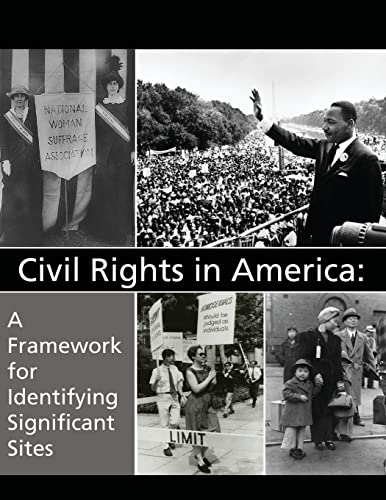Items related to Civil Rights in America: A Framework for Identifying...

In November 1999, the U.S. Congress passed the National Park System New Area Study Act of 2000 (S. 1349) as contained in Public Law 106-113, Appendix C, “National Park Service Studies Act of 1999.” The act instructed the Secretary of the Interior “to direct special resource studies to determine the national significance of the sites, and/or areas, listed in Section 5 of this Act to determine the national significance of each site, and/or area, as well as the suitability and feasibility of their inclusion as units of the National Park System.” Among the areas to be studied were “Civil Rights Sites” on a “multi-state” level. As part of its National Historic Landmarks program, the National Park Service in partnership with the Organization of American Historians (OAH) prepared this civil rights framework study to assist the National Park Service in identifying and prioritizing those areas of history significant in illustrating the civil rights story. Implementation of the framework’s recommendations will help planners evaluate proposals by Congress and others for additions to both the National Park System and the National Trails System, and will also assist the responsible authorities in states, federal agencies, and Indian tribes to identify sites for National Historic Landmarks designation. The period of significance for the study begins in 1776, when Thomas Jefferson wrote in the Declaration of Independence that “all men are created equal.” The period ends in 1976, to include the growing civil rights movements of several minority groups in the dozen years following the passage of the Civil Rights Act of 1964. Before 1776, certainly, the rights of enslaved people, women, American Indians, and immigrants such as the Scots-Irish were routinely violated within the boundaries of the present United States, especially with respect to personal liberty, voting, educational opportunities, property ownership, and religious affiliation. During this period, however, such rights were subject not only to the laws of the mother country but also to the laws and judicial interpretations of the several colonies, some of which took a more liberal approach than did others. There was no national government to define or ensure civil rights, much less a national consensus about what those rights were. It was not until 1776 that a clear statement regarding civil rights rang out, in the words of the Declaration: “We hold these truths to be self-evident: That all men are created equal; that they are endowed by their Creator with certain inalienable rights; that among these are life, liberty, and the pursuit of happiness.” Although Thomas Jefferson’s words have sometimes seemed to ring hollow, they nonetheless constitute one of America’s shining ideals— an inspiration to the world—that all citizens have equal rights and stand equal before the law.
"synopsis" may belong to another edition of this title.
- PublisherCreateSpace Independent Publishing Platform
- Publication date2014
- ISBN 10 1499543263
- ISBN 13 9781499543261
- BindingPaperback
- Number of pages62
Buy New
Learn more about this copy
US$ 19.95
Shipping:
US$ 11.08
From United Kingdom to U.S.A.
Top Search Results from the AbeBooks Marketplace
Civil Rights in America: A Framework for Identifying Significant Sites
Published by
Createspace Independent Publishing Platform
(2014)
ISBN 10: 1499543263
ISBN 13: 9781499543261
New
Paperback / softback
Quantity: > 20
Seller:
Rating
Book Description Paperback / softback. Condition: New. This item is printed on demand. New copy - Usually dispatched within 5-9 working days. Seller Inventory # C9781499543261
Buy New
US$ 19.95
Convert currency

